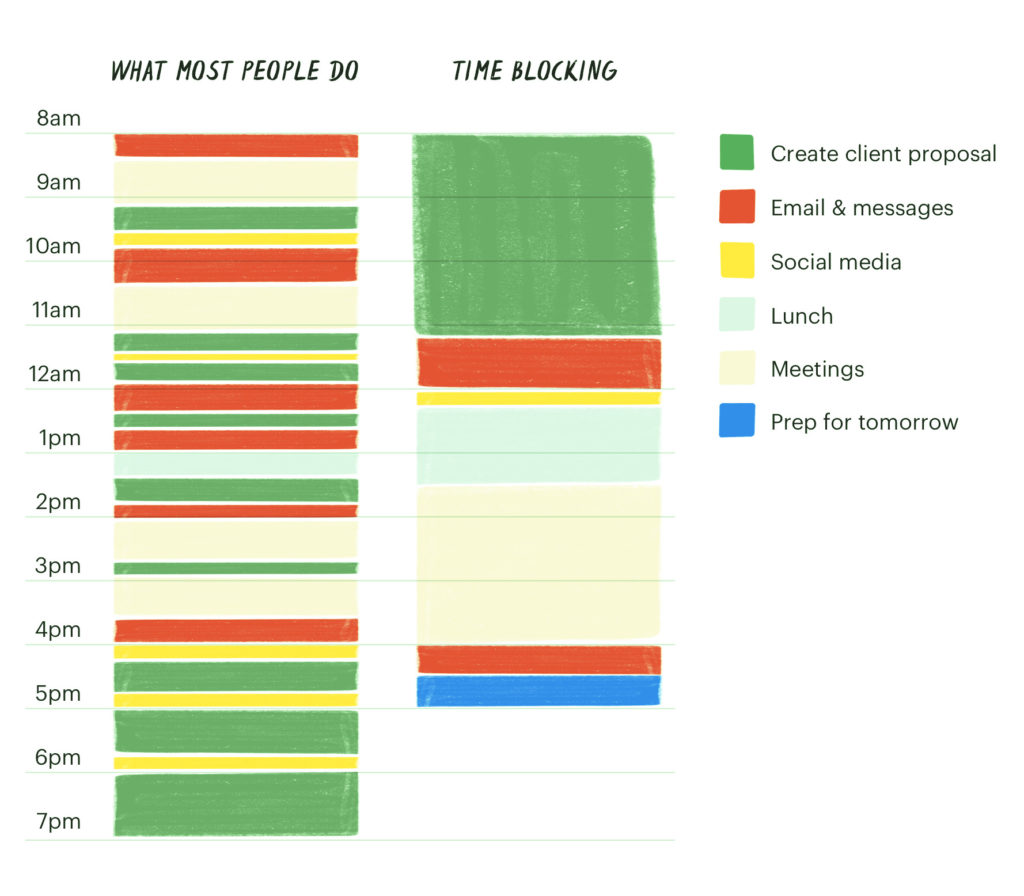In our last blog post, we mentioned using the Time-Blocking Method of organizing your day and were shocked to hear how many people had never heard of time blocking!
Time-blocking is a method of organizing your day to make the most of your time. It’s the idea of controlling your schedule rather than letting your schedule control you!
In the crazy busy world we live in, it is increasingly hard to create a work-life balance and prioritize both the things you have to do and the things you love to do. This is where time-blocking can change your life. I know that’s a big statement, but I stand by it! So let’s look at what time-blocking is and how to start.

What is Time Blocking?
As the name implies, time-blocking is simply a method of organizing your day where you break your day into blocks of time. These blocks are for specific tasks or jobs. For instance, rather than randomly checking your email throughout the day, causing distractions from what you are working on, schedule a 15 to 30-minute “email” block a couple of times daily. Now you know you’ll have a specific time to read and reply to emails. I have mine set for when I clock in, right after lunch, and 30 minutes before the end of the day. This way, I have dedicated time to thoroughly reading and replying to my emails, and I won’t miss anything important.
Why Does Time Blocking Work?
The thing I love most about time-blocking is the freedom it gives your schedule. When You block out your day, you have control over what does and does not happen that day. You also find that a lot of the time you were “working” wasn’t as productive as it could have been. Not because we’re bad employees, but because switching from project to project, to emails, to meetings, back to task, back to meetings… it takes a lot of brain power to switch gears. In that switch over time, we’re just not as productive! Having time set aside to work on and complete one project at a time means your brain has time to sink in and focus on that. And then, when you do switch to another project, you no longer have the other one swimming around your brain. It’s done, and you can move on!
One of the crazy things you’ll find once you start time blocking is how much free time you have during your workday! You’ve just created a time when there was none!
How Does Time Blocking Work Outside The Office?
Once you’ve started time blocking at work, run an experiment by time blocking your life outside of work. For example, do the kids have soccer three nights a week and ballet the other two? Time block for the whole family. Do you and the girls always get together for tea and book club on Wednesday? Time block it. Are you and the guys looking to start a Saturday morning Disc Golf club? Time block it. Time blocking is telling your schedule (and yourself) that this event is your priority, and your calendar isn’t open during those times. I know it sounds rudimentary, but you will be shocked by how much time blocking your family/social life will create so much more free time in your schedule.
How Do I Start?
Looking at your energy levels is a great place to start your time blocking journey. No, really! If you have ever felt like you are fighting your daily schedule, it’s probably because you’re fighting against your natural energy levels.
All of us have energy that ebbs and flows throughout the day, and capitalizing on those ebbs and flows is how time blocking can genuinely change your life. A great example is for those of us who are morning people. If you know your energy is highest at the beginning of the day, that’s the time to block in the projects that require the most energy. So do it when you have it! But even more than that, what is the time of day you feel you have more people’s energy? That’s the time you should be scheduling your meetings or collaborative projects. And we know that not every job can or will allow you to change everyone’s schedule radically, but it’s also worth asking your superiors if you can move a few things around. Especially if you tell them, you’re experimenting with a new way to boost your productivity.
For employers, we highly recommend doing an office survey. For example, the lack of engagement in the weekly staff meeting might have nothing to do with your employee’s engagement and have everything to do with your employee’s energy levels!
Schedule in Care
One of the things I love most about time blocking is that it forces me to slow down and makes it easier to prioritize self-care. For instance, in my current time blocking, I have a set block for therapy immediately, followed by a weekly chiropractor appointment. It’s the best thing ever! So regardless of how busy or stressful my week has been or what kind of worries and woes are affecting me, I know there’s a set time each week when I’ll get to do something that will help me navigate the stress and relieve the worry. And because it’s in my time block, I don’t miss or skip those.
Use your time blocking to schedule in the self-care things you need. Is going to the gym or for a jog a form of self-care for you? Time block it! Is cooking dinner in silence before the kids come home from practicing self-care? Time block it! Don’t forget to include date nights and friend gatherings too. You need time with your partner and community, which should be prioritized! Setting aside a dedicated lunch break is a big part of scheduling your care. Step away from the desk! Go walk in the sunshine! Eat a meal! Caring for your body means you can face your responsibilities with the energy and fuel you need to do them well!
Schedule in Fun!
I love reading. But when I am not time-blocking, I always feel like I never have any time to read. As I mentioned, time-blocking will help show you the gaps in your day, which is excellent, and also means you have to face that your only real excuse for not doing the things you love and having some fun was that you never made time for them! But don’t fret; time-blocking is on a mission to give you back all that spare time and help you make the most of it!
So if you’ve got hobbies and passions you just never seem to get to, block them out! Having fun is really important to our health, and time blocking is a great tool to help you prioritize that fun. You can make space for fun with friends, family, or by yourself, or even switch it up, but whatever you do, make sure there’s at least a little fun every day. This can become the secret weapon in winning a day you know will be challenging. Give yourself permission to play, no matter what the rest of your day looks like. You’ll be better for it!
Change With The Seasons
I don’t mean that you have to have a different time block schedule for each season – though you totally can, and some might find it helpful! What I mean by this is that it’s okay for your schedule to change. I like to think of time blocking as an experiment. I’m hypothesizing the most helpful and productive schedule for me, and then I will run the experiment. After a few weeks, I might find those early morning meetings don’t work for me or find that I am much faster at writing projects in the afternoon rather than in the morning after a few days.
This is your life, and you are ridiculously in control of what it looks like, so finding the schedule that works best for your productivity and peace of mind is worth a few wrong hypotheses.
Share Your Time
A mentor of mine was the one who introduced me to time blocking, and I remember talking about how this method had allowed him to invest in his relationships in a deeper and more meaningful way. When we create our time-blocked schedules, we should share them with the people we’re closest to. Your boss, supervisors, co-workers, spouse or partner, kids, friends… Everyone deserves to know the expectation of when you will and will not be available. One of the benefits of this is that when you are spending regularly blocked out time with a friend or loved one, they know that you’ve prioritized them, and there’s something really special about that.
Another benefit of sharing your schedule is it creates pretty firm boundaries. You can’t take that (non-emergency) midday phone call from your mother because you’re in a time meeting time block and can’t (and more importantly, won’t) answer the call. Your boss can’t expect you to get this last-minute project done because you’ve got to take the kids to practice. It helps every party involved know when you aren’t free and allows you and them to find a time that does work.
But another somewhat unexpected benefit of this system is that when you choose to break the block for someone or something, you’re communicating value to the other parties involved. For example, skipping a staff meeting to see your kid’s assembly performance reminds them that they’re a priority over your schedule. Choosing to grab coffee with a friend rather than stick to your only allotted solo time all week communicates how much you value their friendship. Skipping ladies’ night to sit on the couch with your spouse and watch trash TV proves that your relationship is always the biggest priority.
Sharing your schedule with your circle of people helps keep expectations realistic and allows you to communicate how much you love and appreciate those people in an unexpected way.
Are you ready to try out time-blocking? Still not totally sure how it works? This is a super helpful video tutorial on time blocking and organizing your daily schedule.
Time-blocking helps you take back control of your schedule and do your job better, and it gives you back precious time to live a life you love!


